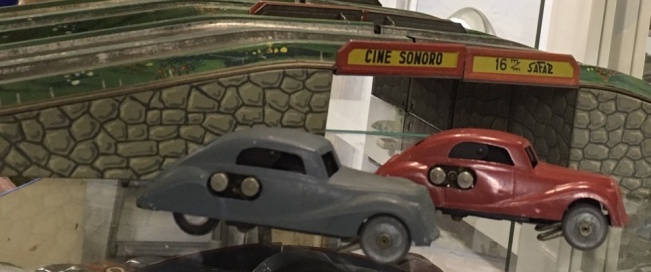SAFAR, 1945- 1948
SAFAR
SAFAR (Società Anonima Fabbricazione Apparecchi Radiofonici) wurde 1923 in Mailand gegründet und stellte ursprünglich Funkgeräte für militärische Zwecke her (heute bekannt als head-sets).
Gegen Ende der 20‘er Jahre wurde der stark expandierende zivile Markt für Radiogeräte bedient und in den 30‘er Jahren gelang SAFAR der Einstieg in die Fernsehtechnik.
Nach dem 2. Weltkrieg hatte das Unternehmen dann große Schwierig-keiten die Produktion wieder in Gang zu bringen. Es fehlte an den liquiden Mitteln und die Technik war inzwischen veraltet. So wurde über neue Produkte nachgedacht und 1945 stieg man in die Spielzeug-produktion ein. Allerdings war 1948 das Kapitel SAFAR eben wegen den finanziellen Problemen dann leider ganz zu Ende.
Es ist daher verständlich, dass die Spielzeuge in dieser relativ kurzen Zeit keine große Verbreitung gefunden haben und heute selten sind, zumal nur 2 Spielzeugvarianten bekannt sind:
Ein einzelnes Auto aus Gussmetall in einer Baugröße von ca. 18 cm und eben eine elektrische Autobahn.
Der Maßstab liegt ähnlich wie bei Tipp & Co und Louis Marx aus den 30’er Jahren bei ca. 1/43. Die Bahn ist wie die beiden anderen er-wähnten Herstellern 2- spurig und die Schienen sind aus Blech ge-fertigt. Sie werden durch Klammern zusammengehalten und ein er-habener Mittelstreifen trennt beide Spuren. Das Bahn-Layout ent-spricht der typischen Acht mit Über- bzw. Unterführung. Außergewöhnlich ist sicherlich der Transformator, der zwei von beiden Seiten identische Regler aufweist. Nur mit diesem ist die Bahn dann 2- spurig zu betreiben.
Die Autos sind bisher nur in den Farben rot und blau-grau bekannt. Die Karosserien sind anders als bei den anderen beiden Herstellern nicht aus Blech sondern aus Gussmetall gefertigt. Das Chassis trägt ein geprägtes Firmenlogo mit der dazugehörigen Patentnummer.
SAFAR
SAFAR (Società Anonima Fabbricazione Apparecchi Radiofonici) was founded in Milan in 1923 and originally manufactured radio equipment for military purposes (now known as head-sets).
Towards the end of the 20’s, the rapidly expanding civilian market for radio sets was served and in the 30’s, SAFAR succeeded in entering television technology.
After the Second World War, the company had great difficulties in getting production back on track. There was a lack of liquid funds and the technology was now out of date. So they thought about new products and in 1945 they started producing toys. However, in 1948 the chapter SAFAR was unfortunately over due to the financial problems.
Therefore it is understandable that the toys have not been widely used in this relatively short time and now are rare of course, especially since only 2 toy variants are known:
A single car made of cast metal in a size of about 18 cm and just an electric track.
Similar to Tipp & Co and Louis Marx from the 1930s, the scale is around 1/43. Like the other two manufacturers mentioned, the track is 2-lane and the rails are made of sheet metal. They are held together by brackets and a raised median separates the two tracks. The layout of the track corresponds to the typical eight with over- and underpass.
The transformer, which has two identical regulators from both sides, is certainly exceptional. This is the only way to operate the track in 2 lanes.
So far, the cars are only known in the colors red and blue-gray. Unlike the other two manufacturers, the bodies are not made of sheet metal but of cast metal. The chassis bears an embossed company logo with the associated patent number.


